Routledge Handbook on Race and Ethnicity in Asia (Routledge 2021)
Michael Weiner (Editor)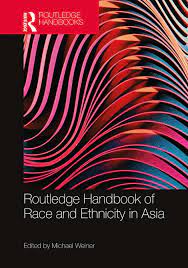
The Routledge Handbook of Race and Ethnicity in Asia introduces theoretical approaches to the study of race, ethnicity and indigeneity in Asia beyond those commonly grounded in the Western experience.
The volume’s twenty-eight chapters consider not only the relationship between ethnic or racial minorities and the state, but social relations within and between individual and transnational communities. These shape not only the contours of governance, but also the means by which knowledge of national identity, ‘self ’, and ‘other’ have been constructed and reconstructed over time. Divided into four sections, it provides holistic and comparative coverage of South, South East, and East Asia, as well as Australasia and Oceania; an area that extends from Pakistan in the West to Hawai’i in the East.
Contributors to this handbook offer a variety of disciplinary and interdisciplinary perspectives, opening a domain of scholarship wherein the relationship between phenotype and racism is less pronounced than European and North American approaches, which have often privileged the so-called ‘colour stigmata’, leading to further exclusions of particular ethnic, racial, and indigenous communities.
This volume seeks to overcome racism and white ideologies embedded in theories of race and ethnicity in Asia, proving a valuable resource to both students and scholars of comparative racial and ethnic studies, international relations and human rights.
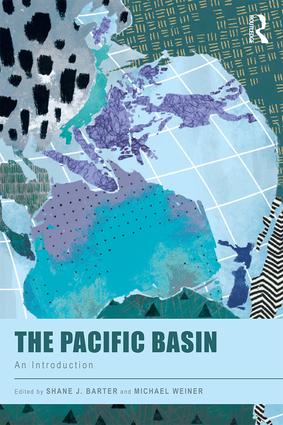 The Pacific Basin: An Introduction (Routledge 2017)
The Pacific Basin: An Introduction (Routledge 2017)
Shane J. Barter and Michael Weiner (Editors)
The Pacific Basin: An Introduction is a new textbook which provides an interdisciplinary and comparative overview of the emerging Pacific world. Interest in the Pacific Basin has increased markedly in recent years, driven largely by the rise of China as a global rival to the United States and Asian development more generally. Growth in eastern Asia, as well as in the western Americas, has led the Pacific Basin to evolve as a dynamic economic zone. To make sense of this transformation, the book:
- Defines the Pacific Basin, locates it in academic research, and explains its importance.
- Addressees the historical origins and evolution of the Pacific Basin and its sub-regions.
- Introduces students to the historical and contemporary relationships, continuities and differences that characterize the region.
- Incorporates analyses of colonialism and imperialism, migration and settlement, economic development and trade, international relations, war and memory, environmental policy, urbanization, mental and public health, gender, film, and literature.
- Connects the diverse peoples of this vast area, explores their common challenges and the diverse responses to these challenges, and provides a window into the lived humanity of the Pacific Basin.
Japan’s Minorities: The Illusion of Homogeneity (Sheffield Centre for Japanese Studies/Routledge) (2009)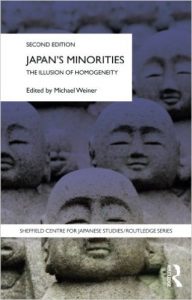
Based on original research, Japan’s Minorities provides a clear historical introduction to the formation of individual minorities, followed by an analysis of the contemporary situation.This second edition identifies and explores the six principal minority groups in Japan: the Ainu, the Burakumin, the Chinese, the Koreans, the Nikkeijin and the Okinawans. Examining the ways in which the Japanese have manipulated historical events, such as Hiroshima and Nagasaki, the contributors reveal the presence of an underlying concept of ‘Japaneseness’ that excludes members of these minorities. The book addresses key themes including:
- the role of this ideology of ‘race’ in the construction of the Japanese identity
- historical memory and its suppression
- contemporary labour migration to Japan
- the three-hundred year existence of Chinese communities in Japan
- mixed-race children in Japan
- the feminization of contemporary migration to Japan.
Still the only scholarly examination of issues of race, ethnicity and marginality in Japan from both a historical and comparative perspective, this new edition will be essential reading for scholars and students of Japanese studies, ethnic and racial studies, culture and society, anthropology and politics.
Race, Ethnicity, and Migration in Modern Japan (Routledge Library of Modern Japan, 3 Volumes, 2005)
Edited with an Introduction by Michael Weiner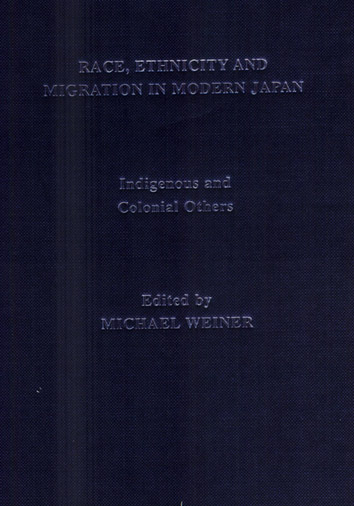
Drawing on the full range of materials published during the twentieth century, this set brings together the essential scholarship concerning the formation of racial identities in Japan, and social exclusion as experienced by the Ainu, Burakumin, Okinawans, and Chinese and Korean residents. It also includes material related to migration, both pre- and post-war, with special reference to the formation of Nikkeijin (Latin American national of Japanese descent) communities, and attitudes towards other imagined minority populations (African Americans and Jews) that have assisted in the shaping of commonsense understanding of ‘Self’ and ‘Other’ in modern Japan. Includes an original introduction and full index.
Japan’s Minorities: The Illusion of Homogeneity (Sheffield Centre for Japanese Studies/Routledge) (1997) 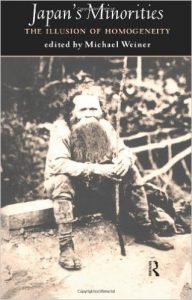
Michael A. Weiner (Editor)
Japan has traditionally projected themselves as a culturally and racially uniform society, while in reality, Japan is home to diverse minority populations. Japan’s Minorities identifies and explores the six principal minority groups in Japan: the Ainu, the Burakumin, the Chinese, the Koreans, the Nikkeijin and the Okinawans. The themes addressed include the role of this ideology of “race” in the construction of the Japanese identity; historical memory and its suppression; contemporary labor migration to Japan; and the three-hundred year existence of Chinese communities in Japan.
Race and Migration in Imperial Japan (The Sheffield Centre for Japanese Studies/Routledge (1994) 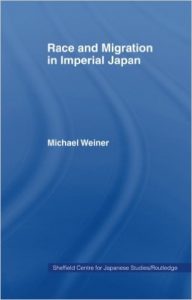
by Michael A. Weiner
A high degree of cultural and racial homogeneity has long been associated with Japan, with its political discourse and with the lexicon of post-war Japanese scholarship. This book examines underlying assumptions. The author provides an analysis of racial discourse in Japan, its articulation and re-articulation over the past century, against the background of labour migration from the colonial periphery. He deconstructs the myth of a `Japanese race’.
Michael Weiner pursues a second major theme of colonial migration; its causes and consequences. Rather than merely identifying the `push factors’, the analysis focuses on the more dynamic `pull factors’ that determined immigrant destinations. Similarly, rather than focusing upon the immigrant, the author examines the structural need for low-cost temporary labour that was filled by Korean immigrants
The Internationalization of Japan (Sheffield Centre for Japanese Studies/Routledge) (1992) 
Michael A. Weiner and Glen D. Hook (Editors)
Foreword Glenn D. Hook Preface Introduction Glenn D. Hook and Michael Weiner Part One: Comparisons: Britain and the United States 1. Internationalization and the National Economy: The British Case Andrew Gamble 2. American Hegemony and the Japanese Challenge Richard Falk Part Two: Meanings and Implications 3. Interdependence and Internationalization Ogata Sadako 4. Internal and External Aspects of Internationalization Sugiyama Yasushi 5. The Internationalization of Political Thought: Liberal Democracy in Japan Tanaka Hiroshi Part Three: Japan and the World Economy 6. Gearing Economic Policy to International Harmony Yamazawa Ippei 7. The Internationalization of Japanese Capital Sakamoto Katsuzo and Richard C. Conquest 8. Internationalization of the Japanese Automobile Industry Shimokawa Koichi Part Four: National and Local Politics 9. Japan’s Political Change Towards Internationalization: Grafted Democracy and Political Recruitment Yakushiji Taizo 10. The Internationalization of Kanagawa Prefecture Takahashi Susumu Part Five: Labour Markets and Migrant Workers 11. Migrant Workers: The Japanese Case in International Perspective Yoko Sellek and Michael Weiner 12. Reciprocity and Migrant Workers Hatsuse Ryuhei 13. The Trade Union Response to Migrant Workers Nimura Kazuo Part Six: Education and the Individual 14. The Internationalization of Education Ehara Takekazu 15. Data Protection and the Individual Horibe Masao Part Seven: The Future 16. Towards a New Departure: Alternatives for Japan Nagai Michio 17. The Internationalization of Japan Kato Shuichi
The Origins of the Korean Community in Japan, 1910-1923 (1990) 
by Michael Weiner
This is the first major study in English of the Korean minority in Japan. It traces the origins of the Korean community, the colonial context of Korean immigration, the living and working conditions of the Koreans, and their persecution after the Great Kanto Earthquake of 1923. The book constitutes an economic and social history of Japan during the period of its transformation from an isolated state into a modern imperial power.
Articles in Scholarly Journals/Chapters in Books
- (2020) “Leprosy Control in Imperial Japan”, in The Shapes of Epidemics and Global Disease, A. Patterson and I. Read (eds) (Cambridge Scholars): 87-109
- (2017) “Introduction to the Pacific Basin” (with S. Barter), in The Pacific Basin: An Introduction, S. Barter and M. Weiner (eds) (Routledge): 1-10
- (2017) “East Asia: Convergence and Divergence,” in The Pacific Basin: An Introduction, S. Barter and M. Weiner (eds) (Routledge): 35-45
- (2017) “The Pacific War: Remembering and Forgetting,” in The Pacific Basin: An Introduction, S. Barter and M. Weiner (eds) (Routledge): 81-90
- (2017) “Migration, immigration and Settlement in the Pacific Basin” (with S. England), in The Pacific Basin: An Introduction, S. Barter and M. Weiner (eds) (Routledge): 91-100
- (2017) “State Building, Disease, and Public Health” (with I. Read), in The Pacific Basin: An Introduction, S. Barter and M. Weiner (eds) (Routledge): 158-167
- (2013) “Myth and Reality: the Great Kanto Earthquake,” in Critical Readings on Ethnic Minorities and Multiculturalism in Japan, R. Siddle (ed), (Brill) 65-101
- (2004) “Ninchi sarenai mainoritii; chôsenjin hibakusha” (An Unknown Minority; Korean Victims of the Atomic Bomb), Shimane Law Review 48:3: 167-195
- (2003) “Japan in the Age of Migration,” in Japan and Global Migration: Foreign Workers and the Advent of a Multicultural Society, M. Douglas and G. Roberts (eds) (Routledge, ): 53-70
- (2000) “Japan in the Age of Migration,” in Japan and Global Migration: Foreign Workers and the Advent of a Multicultural Society, M. Douglass and G. Roberts (eds) (Honolulu: University of Hawaii Press): 52-70
- (2000) “Destination Japan: Migration in the Twentieth Century,” Pan-Japan: The International Journal of the Japanese Diaspora 1:1: 49-75
- (1998) “Ideologie und Identitat im Modernen Japan. Die Koreanische Minderheit,” in Korea Forum 8:1: 34-38
- (1997) “The Invention of Identity: Race and Nation in Japan,” in The Construction of Racial Identities in China and Japan, F. Dikotter (ed) (C. Hurst & Co.): 96-118
- (1997) “Editor’s Introduction,” in Japan’s Minorities: The Illusion of Homogeneity, M. Weiner (ed), (Routledge): xi-xviii
- (1997) “Identity Constructed: Self and Other in Japan,” in Japan’s Minorities: The Illusion of Homogeneity, M. Weiner (ed), (Routledge):1-17
- (1997) “The Absence of Representation and The Representation of Absence: Koreans in Japan,” in Japan’s Minorities: The Illusion of Homogeneity, M. Weiner (ed), (Routledge): 79-108
- (1997) “Okinawa, Fifty Years After the Pacific War” (with Koji Taira), in Japan’s Minorities: The Illusion of Homogeneity, M. Weiner (ed), (Routledge): 169-177
- (1996) “Fortress Japan: Racism and Migrant Labour,” in Labour Movements and Migration, C. Schindler (ed), (Internationale Tagung der Historikerinnen und Historiker Der Arbeiterinnen – und Arbeiterbewegung, Wien): 240-260
- (1996) “The Comintern in East Asia, 1919-39”, in The Comintern: A History of International Communism from Lenin to Stalin, K. McDermott and J. Agnew (eds), (Macmillan): 158-190; Japanese edition, Kominternshi: Renin kara Sutarin e (Otsuki Shoten, 1998): 220-258
- (1996) “The Racialization of National Identity in Japan,” in Racial Identities in East Asia, B. Sautman (ed), (Hong Kong University of Science and Technology): 251-266
- (1995) “Out of the Very Stone; Korean Hibakusha,” Immigrants and Minorities 14:1: 2-25
- (1995) “Discourses of Race and Nation in Pre-1945 Japan,” Ethnic and Racial Studies 18:3: 433-56
- (1993) “Long Long Autumn Nights: The Korean Community in Japan”, in Ten Years of Korean Studies in Sheffield, J.H. Grayson (ed), (Sheffield Academic Press: 166-193
- (1992) “Introduction” (with G.D. Hook), in The Internationalization of Japan, M.A. Weiner and G.D. Hook (eds) (Routledge): 1-12
- (1992) “Migrant Workers in Japan, An International Perspective” (with Y. Sellek), in The Internationalization of Japan, M.A. Weiner and G.D. Hook (eds) (Routledge): 205-229
- (1983) “Koreans in the Aftermath of the Kanto Earthquake,” Immigrants and Minorities 2:1: 5-32
- (1981) “The Korean Student Movement in Japan, 1910-1919,” Proceedings of the British Association for Japanese Studies: 2-18
